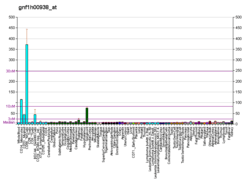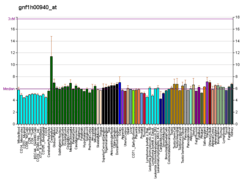HAVCR2
Hepatitis A virus cellular receptor 2 (HAVCR2), also known as T-cell immunoglobulin and mucin-domain containing-3 (TIM-3), is a protein that in humans is encoded by the HAVCR2 gene.[5][6]
Function
CD4-positive T helper lymphocytes can be divided into several types (including types 1 (Th1) and 2 (Th2)) on the basis of their cytokine secretion patterns. Th1 cells and their associated cytokines are involved in cell-mediated immunity to intracellular pathogens and delayed-type hypersensitivity reactions, whereas Th2 cells are involved in the control of extracellular helminthic infections and the promotion of atopic and allergic diseases. The 2 types of cells also cross-regulate the functions of the other.
T-cell exhaustion is mediated by several inhibitory receptors including programmed cell death protein 1 (PD1), TIM3, and lymphocyte activation gene 3 protein (LAG3).[7] TIM3, an immune checkpoint, is a Th1-specific cell surface protein that regulates macrophage activation and enhances the severity of experimental autoimmune encephalomyelitis in mice.[6]
Clinical significance
The Tim-3 pathway may interact with the PD-1 pathway in the dysfunctional CD8+ T cells and Tregs in cancer.[8][9]
References
- 1 2 3 GRCh38: Ensembl release 89: ENSG00000135077 - Ensembl, May 2017
- 1 2 3 GRCm38: Ensembl release 89: ENSMUSG00000020399 - Ensembl, May 2017
- ↑ "Human PubMed Reference:".
- ↑ "Mouse PubMed Reference:".
- ↑ Monney L, Sabatos CA, Gaglia JL, Ryu A, Waldner H, Chernova T, Manning S, Greenfield EA, Coyle AJ, Sobel RA, Freeman GJ, Kuchroo VK (Feb 2002). "Th1-specific cell surface protein Tim-3 regulates macrophage activation and severity of an autoimmune disease". Nature. 415 (6871): 536–41. PMID 11823861. doi:10.1038/415536a.
- 1 2 "Entrez Gene: HAVCR2 hepatitis A virus cellular receptor 2".
- ↑ Mahoney KM, Rennert PD, Freeman GJ (2015). "Combination cancer immunotherapy and new immunomodulatory targets". Nat Rev Drug Discov. 14 (8): 561–84. PMID 26228759. doi:10.1038/nrd4591.
- ↑ Anderson AC (May 2014). "Tim-3: an emerging target in the cancer immunotherapy landscape". Cancer Immunology Research. 2 (5): 393–8. PMID 24795351. doi:10.1158/2326-6066.CIR-14-0039.
- ↑ Gao X, Zhu Y, Li G, Huang H, Zhang G, Wang F, Sun J, Yang Q, Zhang X, Lu B (2012). "TIM-3 expression characterizes regulatory T cells in tumor tissues and is associated with lung cancer progression". PLOS ONE. 7 (2): e30676. PMC 3281852
 . PMID 22363469. doi:10.1371/journal.pone.0030676.
. PMID 22363469. doi:10.1371/journal.pone.0030676.
Further reading
- Anderson DE (2007). "TIM-3 as a therapeutic target in human inflammatory diseases". Expert Opin. Ther. Targets. 11 (8): 1005–9. PMID 17665973. doi:10.1517/14728222.11.8.1005.
- Sánchez-Fueyo A, Tian J, Picarella D, Domenig C, Zheng XX, Sabatos CA, Manlongat N, Bender O, Kamradt T, Kuchroo VK, Gutiérrez-Ramos JC, Coyle AJ, Strom TB (2003). "Tim-3 inhibits T helper type 1-mediated auto- and alloimmune responses and promotes immunological tolerance". Nat. Immunol. 4 (11): 1093–101. PMID 14556005. doi:10.1038/ni987.
- Sabatos CA, Chakravarti S, Cha E, Schubart A, Sánchez-Fueyo A, Zheng XX, Coyle AJ, Strom TB, Freeman GJ, Kuchroo VK (2003). "Interaction of Tim-3 and Tim-3 ligand regulates T helper type 1 responses and induction of peripheral tolerance". Nat. Immunol. 4 (11): 1102–10. PMID 14556006. doi:10.1038/ni988.
- Khademi M, Illés Z, Gielen AW, Marta M, Takazawa N, Baecher-Allan C, Brundin L, Hannerz J, Martin C, Harris RA, Hafler DA, Kuchroo VK, Olsson T, Piehl F, Wallström E (2004). "T Cell Ig- and mucin-domain-containing molecule-3 (TIM-3) and TIM-1 molecules are differentially expressed on human Th1 and Th2 cells and in cerebrospinal fluid-derived mononuclear cells in multiple sclerosis". J. Immunol. 172 (11): 7169–76. PMID 15153541. doi:10.4049/jimmunol.172.11.7169.
- Chae SC, Park YR, Shim SC, Yoon KS, Chung HT (2005). "The polymorphisms of Th1 cell surface gene Tim-3 are associated in a Korean population with rheumatoid arthritis". Immunol. Lett. 95 (1): 91–5. PMID 15325803. doi:10.1016/j.imlet.2004.06.008.
- Chae SC, Park YR, Lee YC, Lee JH, Chung HT (2005). "The association of TIM-3 gene polymorphism with atopic disease in Korean population". Hum. Immunol. 65 (12): 1427–31. PMID 15603868. doi:10.1016/j.humimm.2004.07.002.
- Zhu C, Anderson AC, Schubart A, Xiong H, Imitola J, Khoury SJ, Zheng XX, Strom TB, Kuchroo VK (2006). "The Tim-3 ligand galectin-9 negatively regulates T helper type 1 immunity". Nat. Immunol. 6 (12): 1245–52. PMID 16286920. doi:10.1038/ni1271.
- Sui L, Zhang W, Chen Y, Zheng Y, Wan T, Zhang W, Yang Y, Fang G, Mao J, Cao X (2006). "Human membrane protein Tim-3 facilitates hepatitis A virus entry into target cells". Int. J. Mol. Med. 17 (6): 1093–9. PMID 16685421. doi:10.3892/ijmm.17.6.1093.
- Koguchi K, Anderson DE, Yang L, O'Connor KC, Kuchroo VK, Hafler DA (2006). "Dysregulated T cell expression of TIM3 in multiple sclerosis". J. Exp. Med. 203 (6): 1413–8. PMC 2118310
 . PMID 16754722. doi:10.1084/jem.20060210.
. PMID 16754722. doi:10.1084/jem.20060210. - van de Weyer PS, Muehlfeit M, Klose C, Bonventre JV, Walz G, Kuehn EW (2007). "A highly conserved tyrosine of Tim-3 is phosphorylated upon stimulation by its ligand galectin-9". Biochem. Biophys. Res. Commun. 351 (2): 571–6. PMID 17069754. doi:10.1016/j.bbrc.2006.10.079.
- Wiener Z, Kohalmi B, Pocza P, Jeager J, Tolgyesi G, Toth S, Gorbe E, Papp Z, Falus A (2007). "TIM-3 is expressed in melanoma cells and is upregulated in TGF-beta stimulated mast cells". J. Invest. Dermatol. 127 (4): 906–14. PMID 17096021. doi:10.1038/sj.jid.5700616.
- Renesto PG, Ponciano VC, Cenedeze MA, Saraiva Câmara NO, Pacheco-Silva A (2007). "High expression of Tim-3 mRNA in urinary cells from kidney transplant recipients with acute rejection". Am. J. Transplant. 7 (6): 1661–5. PMID 17430399. doi:10.1111/j.1600-6143.2007.01795.x.
- Anderson AC, Anderson DE, Bregoli L, Hastings WD, Kassam N, Lei C, Chandwaskar R, Karman J, Su EW, Hirashima M, Bruce JN, Kane LP, Kuchroo VK, Hafler DA (2007). "Promotion of tissue inflammation by the immune receptor Tim-3 expressed on innate immune cells". Science. 318 (5853): 1141–3. PMID 18006747. doi:10.1126/science.1148536.





